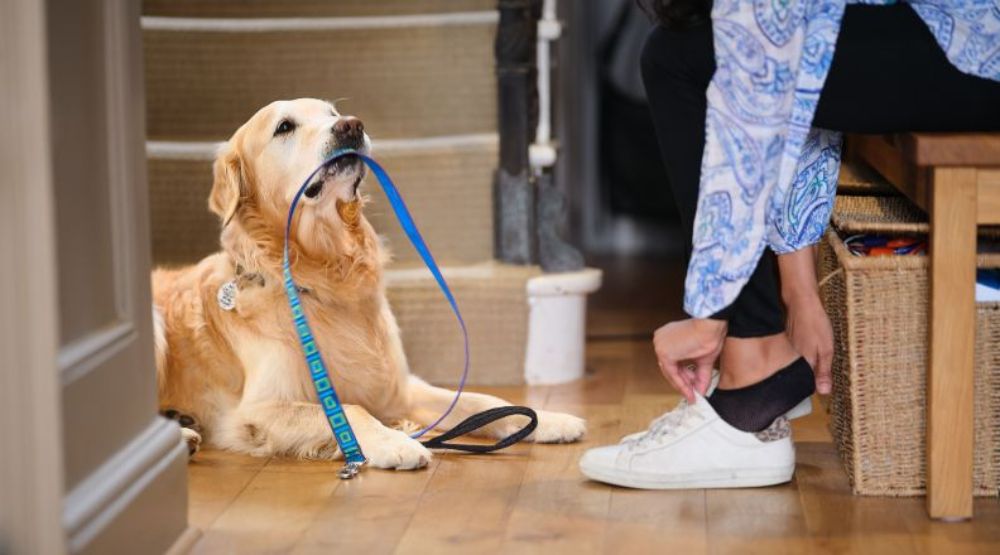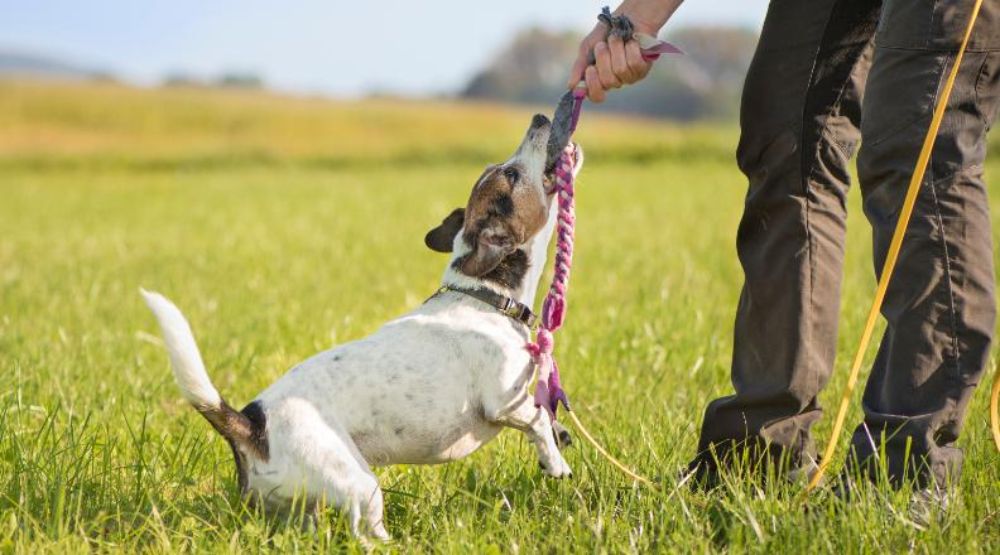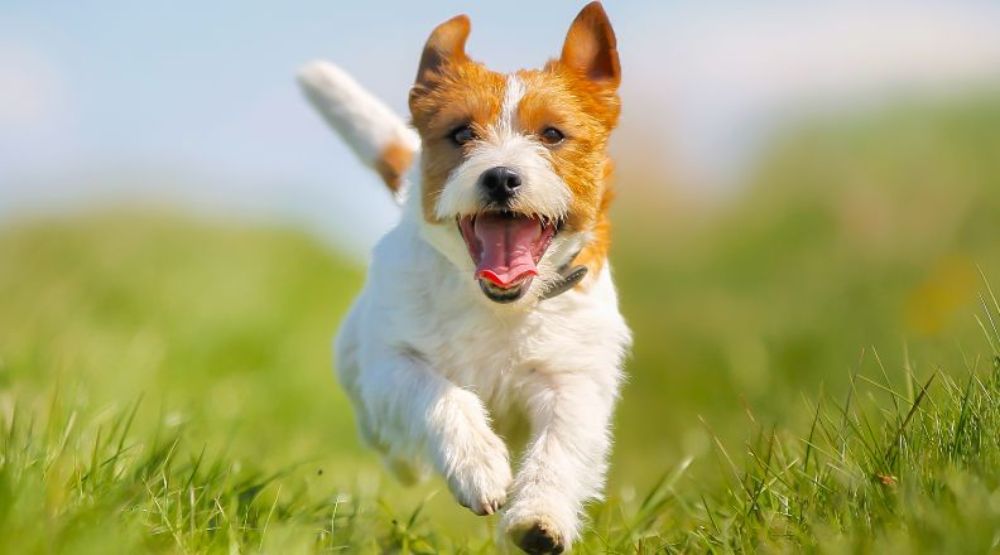
Exercise is a great way for everyone to stay happy and healthy, reduce boredom, improve fitness levels, and prevent obesity. It will also be a healthy activity for both of you! Dogs love to be active, and regular forms of exercise with your dog, whether walking in the park or playing games, will strengthen your bond.
To help you understand the importance of exercise for your dog, we have joined up with Vetstream, experts in the veterinary field, and put together some information on dog exercise, including how much exercise your dog may need and which exercises are best.
How Much Exercise Does My Dog Need?
How much exercise your dog needs depends on your dog's age, breed and health. Puppies don't need as much exercise as adult dogs - too much exercise can cause damage to a puppy's developing joints.
Some breeds need more exercise than others; for example, Spaniels are extremely active so need plenty of exercise. Some breeds, like the toy breeds, bred for companionship, require much less exercise. Large breeds of dogs can be prone to joint problems too – if in doubt, ask your vet for advice.
Recommended Exercise for Small Dogs – Under 10kg
In general medium-sized dogs need at least an hour of exercise a day. You could split this into a couple of 30 minute walks every day, depending on your routine and your dog's energy. If your dog is a particularly energetic breed and full of beans, you might need to exercise them for much longer. Just like small dogs, medium-sized dogs are prone to become troublesome if they don't get enough exercise.
Recommended Exercise for Medium Dogs – Between 10-25kg
In general medium-sized dogs need at least an hour of exercise a day. You could split this into a couple of 30 minute walks every day, depending on your routine and your dog's energy. If your dog is a particularly energetic breed and full of beans, you might need to exercise them for much longer. Just like small dogs, medium-sized dogs are prone to become troublesome if they don't get enough exercise.
Recommended Exercise for Large Dogs – Over 25kg
It's not always the rule that large dogs need a lot of exercise. While most active dogs need around 60-90 minutes of exercise daily, some giant breeds like the Great Dane, Newfoundlands and Mastiffs are less active. In fact, too much exercise can cause joint problems in these breeds, so a careful balance of diet and exercise is essential.

8 Ways to Exercise Your Dog
Going for lovely long walks is great, but it's good to vary the route and mix in some games and challenges along the way. Take along a ball or frisbee, or try some of the following:
- Walking: hiking, woodland walks, dog-friendly beaches
- Jogging, roller skating or cycling: if your dog is on a lead, make sure you don't go too far or fast for your dog's ability
- Swimming: some dogs love swimming. Make sure the area is safe first (no strong currents, deep water or areas where they can't climb out). They can wear a life jacket, or a long nylon lead can be attached to them to prevent them from swimming out too far
- Agility: a sport where the handler guides their dog around an obstacle course
- Flyball: especially good for breeds with really high activity levels like Border Collies
- Play-dates: join up with doggy friends to make exercise fun
- Dog parks or fields: a chance to sniff out new territory while off the lead in a safe enclosed area
- Brain games: food puzzles, activity toys, teaching new tricks
Exercises to Avoid With Your Dog
Brachycephalic dog breeds (with flat faces and short noses) like French Bulldogs and Pugs can get out of breath quickly, especially if it's hot. It's best to avoid high activity exercise with these breeds.
While playing fetch with your dog, avoid throwing sticks. These can splinter and break and get lodged in your dog's mouth, throat or stomach.
Dogs need regular exercise regardless of the weather outside. If it's hot out, don't over-exercise your dog. If it's miserable, some dogs like Whippets and Greyhounds or other small breeds like Dachshunds will appreciate wearing a warm, waterproof coat.
Also, be mindful of the pavement. The hot ground can burn their paws. When it's hot, it's best to walk your dog first thing in the morning or later in the evening. Don't walk them during the day when the sun's at its hottest.
Common Dog Injuries From Exercise
Dogs can suffer muscle, tendon, ligament and joint injuries, especially from high-activity exercise. If they are reluctant to exercise or are limping, ask your vet for advice.
Older dogs may suffer from osteoarthritis, and too much exercise will cause more pain and stiffness. Ask your vet for the best exercise plan for your dog if they suffer from joint disease.
It's also worth mentioning heat stroke. If it's very hot, avoid taking your dog out during the middle of the day. This is especially important for obese dogs, brachycephalic dogs and dogs with thick coats designed for more wintry climates. Walking your dog on very hot pavements can also cause burns on their sensitive paw pads.
Dog Breeds That Need a Lot of Exercise
High-energy breeds can need more than 2 hours of exercise each day – a big commitment. This can be broken down into 30 to 60 minutes of exercise 2 to 4 times a day. Don't limit their physical activity to just dog walks. Swimming, playing fetch, play tug of war games and dog sports are also great ways for them to get the exercise they need.
These 5 breeds need more than 2 hours of exercise a day:
- Labrador Retriever
- Dalmatian
- Alaskan Malamute
- Border Collie
- Boxer
Dog Breeds That Don’t Need a Lot of Exercise
Dogs with low energy levels may only need 10 to 20 minutes of exercise once or twice a day to stay fit and healthy. If this sounds more your style, these are the top 5 breeds that only need around 20 to 40 minutes of exercise a day:
- Bulldog
- Dachshund
- Bassett Hound
- French Bulldog
- Pekingese
How to Introduce Exercise to My Overweight Dog
If your dog is overweight, start slowly! Maybe start an exercise routine with two 10-minute walks every day and gradually increase the length and number of walks per day. Vary the walking route - your dog will enjoy their walks more if there are new things to smell and see. Add in some fun games or challenges, take a ball for them to chase or a frisbee to catch. Let them off the leash if in a safe, secure area.
Never force them to exercise if it leaves them exhausted, struggling to breathe or looking stiff when they move around.
Health Benefits for You and Your Dog
There's a breed to suit every lifestyle, so whether you're an active dog owner or a sofa surfer, there's a dog to match. It's good both physically and mentally to get outdoors for some exercise for both of you. The shared experience will strengthen your bond as well as being fun and stimulating for your dog. After exercising, your dog will feel more relaxed and happy to chill out back at home. Happy dog, happy owner!

Everypaw Dog Insurance
Everypaw's Dog Insurance comes with 24/7 unlimited access to vets and vet nurses that can help with your pet's health, care, nutrition and behaviour. So you can rest assured your pup will be well looked after. Get a quote today!
Content provided from by Vetstream's Vetlexicon - www.vetstream.com/treat/canis
Vetlexicon is the world’s largest peer-reviewed online clinical reference source. All our content is written and peer-reviewed by over 1,000 of the world’s leading veterinarians, ensuring relevance, accuracy and quality.
- Vetstream Ltd (online) Exercise – for a healthy, happy dog Client Information. In: Vetlexicon Canis. Vetstream Ltd, UK. Website: https://www.vetlexicon.com/treat/canis/client-information/exercise-for-a-healthy,-happy-dog